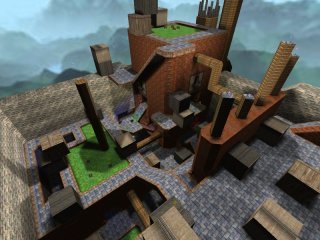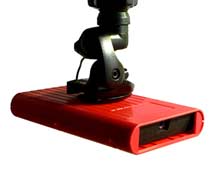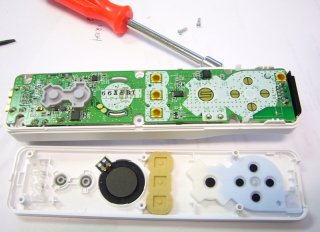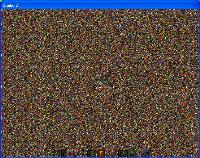|  |
|
tech: Camspace: Markerless Tracking that's Free (as-in-beer)
|
|

 A small team in Tel Aviv, Israel has been working on what they describe as a paradigm shift in gaming: rather than using an input device like a WiiMote or mouse+keyboard (almost) any object in the room can be trained to be tracked by a standard webcam and their software. A small team in Tel Aviv, Israel has been working on what they describe as a paradigm shift in gaming: rather than using an input device like a WiiMote or mouse+keyboard (almost) any object in the room can be trained to be tracked by a standard webcam and their software.
Check out their impressive demo here. They just pick up a brightly coloured object, train and then track.
To be fair, this technology has been around for quite a while in computer vision, popularised most of all by Intel's OpenCV library which allows for defining and tracking many different Regions Of Interest (to unpack a geeky acronym).
Read on for more about this great technology (and why it won't displace the WiiMote any time soon)..
|
|
tech: Global DoD Sim puts you in the picture.
|
|

"The US Department of Defense (DOD) may already be creating a copy of you in an alternate reality. Putting supercomputers to an innovative use, the military is simulating our planet in an effort to predict the outcome of different scenarios. They might run tests to see how long 'you' can go without food or water, or how 'you' will respond to televised propaganda. Billions of nodes are created in the system, intended to reflect every man, woman, and child.
'Called the Sentient World Simulation (SWS), it will be a "synthetic mirror of the real world with automated continuous calibration with respect to current real-world information", according to a concept paper for the project. Simulex is the company developing these systems, and they list pharmaceutical giant Eli Lilly and defense contractor Lockheed Martin among their private sector clients.
The U.S. military is their biggest customer, apparently now running the most complex version of the system. JFCOM-9 is now capable of running real-time simulations for up to 62 nations, including Iraq, Afghanistan, and China. The simulations gobble up breaking news, census data, economic indicators, and climactic events in the real world, along with proprietary information such as military intelligence."
Via /.
|
|
tech: First Wii-Mote on PC homebrew surfaces
|
|

Recently I wrote about the console hacking talk at the 23C3 in Berlin. The article recounts Felix's fine suggestion that a Wii-Mote and a PC is all you need to explore developing interactive content along the lines of what you see on the console itself.
With typically good timing, Chris O'Shea writes with a fine link exposing the internals of the Wii-Mote, just to demystify the whole interface further.
Aside from the obvious cultural kudos granted by using a Wii-Mote in your art project, it's worth mentioning that the Wii-mote isn't new technology in itself. What it is however is perhaps the first economically sane intersection of several technologies many performance artists/musicians have been using for a while: Accelerometers and a couple of IR sensors used for positioning. The fact it's a bluetooth device also makes it far more accessible to those of us that don't want to D.I.Y an interface between the sensors and a machine, especially now that several tookits are now surfacing that do alot of the technical groundwork.
That said, if you're prone to a healthy bout of the N.I.H syndrome, and want to build your own super Wii-Mote, you could avoid bluetooth altogether and go wireless. That'll give you far more range than a bluetooth device ever will. Good luck with capturing positional info with IR over that range though; albeit not necessary if gesture is your primary control data..
Chris also points us to a super YouTube clip of a WiiPC interface aptly called WiiSticks that really exploits the accelerometers to a maximum as a function of play.
While we're at it, here's another YT clip showing how the Wii can be used to navigate a Linux desktop machine. Note the candles in the foreground which he seems to be using as InfraRed emitters so he can get that positional data. The API they're using for this demo is here.
Cheers Chris!
|
|
tech: Second Life open-sources their client software.
|
|

A big thumbs-up to Linden Labs: today they announced the smart move of releasing their Second Life client under an open-source license.
From the SL blog post:
Stepping up the development of the Second Life Grid to everyone interested, I am proud to announce the availability of the Second Life client source code for you to download, inspect, compile, modify, and use within the guidelines of the GNU GPL version 2.
SL is high profile software in the marketplace. Let's hope this nudges some of the other big kids to get with the 2000's; letting those of us that know how improve the software we use.
|
|
tech: Boot any Linux Distro on your PS3
|
|

Admittedly this is a bit premature, given anyone outside of Japan won't be seeing PS3's for a few months, but..
As the geeks amongst you are probably aware, YellowDog Linux is the (reportedly) official homebrew OS of the PlayStation3. However, as this guide shows, it should be fairly trivial to boot (cough) more interesting OS's, like Ubuntu, or it's Zen parent Debian. The site has patches, a bootloader and documentation to get you on your merry way. When the PS3 is cheaper than a full-body transplant, I'll be buying one myself and will certainly be giving Ubuntu or Debian on the PS3 a crack, now that I know this is possible.
I think I speak for alot of us in saying that Sony only needs to make the development and distribution of content for their platform freely available in order to compete against the Xbox360 and the Wii in the coming years. If the rumours are true, perhaps the PS3 will be as much of a cultural revolution as its predecessor; a console that admits the present-day gamer is often one that has his/her own ideas and is in search of tools to freely produce them. We saw this happen in the modding and mapping scene - let's see if the same can happen in the console universe..
Besos to the all-seeing LaPetiteClaudine for this story.
|
|
tech: Royalty-free tileable texture pack released
|
|

Making textures loop along a mesh without discernable points of repitition can be a painful experience. The kind folk at Spiral Graphics have released a pack of 150 quality seamless tiling textures for free download and distribution, bless their pixelated souls.
Looking at a few of them it appears they're well suited for converting to bump-maps too. Grab them here.
|
|
tech: Game code available
|
|
 Anonymous writes "Thought I'd let you all know I've pulled out of game dev (I have been doing a research masters in comp-sci on real-time audio synthesis for computer games and have been acting head of a games reseach lab this last semester). Getting involved in commercial game dev means getting ripped off and burnt along with making truly crap games (oh what an industry!) and I find teaching it to be unethical in Australia at this point in time, primarily due to industry size and attitudes.
Anonymous writes "Thought I'd let you all know I've pulled out of game dev (I have been doing a research masters in comp-sci on real-time audio synthesis for computer games and have been acting head of a games reseach lab this last semester). Getting involved in commercial game dev means getting ripped off and burnt along with making truly crap games (oh what an industry!) and I find teaching it to be unethical in Australia at this point in time, primarily due to industry size and attitudes.
I've released some code from my studies recently, anyone working on multithreaded real-time software or game engine development may find it useful.
http://ldk.sourceforge.net
Lorien Dunn
acmipark Sound Programmer"
|
|
tech: Ubuntu-6.06: OpenSource Game-dev platform of choice.
|
|

Ubuntu, the free OS used by millions of people the world over reached it's 6.06 milestone today. It's a stunner of a release and now has a try-before-you-buy 'LiveCD'; just boot up without installing anything and if you like what you see, click the 'Install' icon. Download it here (try the torrents for a snappy download).
Ubuntu comes with the Selectparks Special Nod for those interested in a solid, easy to use, low-maintenance platform for open-source game development. Like many Linux distributions Ubuntu is based on the all incumbent Debian, reknowned for it's excellent software management system and stability. There are 17000+ software free-software packages available in Ubuntu and are downloaded from a secure and geographically local repository on demand. There's no hunting around websites to find and install software and all software on your machine can be upgraded simultaneously, at any time, with just a few clicks.
This makes it fantastic as a stable development machine (and also as a desktop). If you want to install Python OpenGL bindings, SDL joystick support along with the sourcecode for an RPG you find in the package manager, they are just a click away..
|
|
tech: Smart Retina And MossaLibra
|
|
 Anonymous writes "
Anonymous writes " SmartRetina is a lightfast gesture-tracking platform written in Macromedia Flash 8, utilizing its flash.geom. package, flash.display package, Video class, Camera class and their motion-tracking capabilities. SmartRetina is used to develop Retina Based Interfaces – Interfaces which: 1. Purely use visual interaction and can fully function without using text or audio.
2. Strictly serve as translators between human gestures and machine functions.
3. Can be self-explanatory at their introductory level, since representations of the supported gestures can serve as the actual visual interface (a reflexive interface)
4. Can act as self-organizing systems (see Mossalibra for example). |


Chris of Pixelsumo wrote to me about a collaborative project he worked on that uses a light-table and small sound-toys. Reverberations from the units are sensed by the table and are represented by ripples and other events, much as they would in a pool of water.
Something that immediately struck me when looking at photos was the possibilities an interface like this could offer gaming, perhaps even reinventing that most geeky of genres, the table-top game, in a completely new light (so to speak). More so I'd love to see a sound-space shooter like Sphere's of Chaos on this thing; a hands-on acoustic feedback game.
Cheers Chris.
|


Last night while taking a hiatus from the stomp at Club Transmediale, Derek Holzer handed out a flyer with an interesting offer: take any music of yours on file to a given location and they will burn you a single, one-off vinyl record all for yourself. Here's their project page.
While chatting with friends about this I suggested the possibility of writing code for a videogame onto the vinyl so that it could later be parsed, compiled and played. This was my waking thought of the morning. I prayed to The Knowledge Architect and design was delivered. While I was well aware of multiplexed radio transmissions being used to deliver game content in the mid 80's (like that for the Atari 2600), I had no idea that bands like the Thompson Twins were featuring bonus tracks that could be copied to cassette and run on the Zx Spectrum. Lovely!
Read all about it here. FYI yes, I'm working on one of my own now.
|
|
tech: Interactive Fiction Engine Seeks Loving Parents.
|
|


From my sentimental perspective, 'Interactive Fiction' never did get better than Ian Livingstone's Deathtrap Dungeon; there was enough suspense between those two covers to hang a Neutral-Evil Ice-Basilisk by it's very sharp toenails. The 'Apotheosis Engine' however summons Interactive Fiction in a digital form, and was developed as part of comp-sci coursework on object-oriented programming. While they aren't shipping their demo/prototype, the team have posted a breakdown of their trials and tribulations developing the game, which makes for an interesting read in itself.
Of note is that they are looking for people to 'revive' the project. If interactive fiction is your game and you're handy with Java, then this little engine could form the basis of a fine project. The Apotheosis Engine already sports an API, scripting interface and game editor.
|

And on the topic of free game dev frameworks, Edge is an OSS "spawned from the Doom Engine, EDGE advances into the future with easy development and expansion as a cornerstone, making use of advancing technology and supporting a variety of platforms, this adds a new dimension to 3D gaming."
Runs on a variety of Win and Unixs.
http://sourceforge.net/projects/edge
|

Multiverse promises to be a 'free' kit for rapidly developing MMO[RPG]'s. At the outset it seems their heart is certainly in the right place, though I'm a little confused about the specifics of their licensing model and why they have chosen Axiom, the C# port of the far more popular Ogre3D as their renderer.
Their technology platform is also a little thin on details as they don't go into specifics on the client-server model; it's here that scalability and overall robustness will be tested the greatest in any MMO project.
Vapourware? I hope not! It is projects like Multiverse Realmforge and Yake that significantly lower the entry barrier for those with the real ideas...
We'll find out more when the beta of their demo Kothuria ships early 2006.
|


Alison Mealy's Unrealart
plots the movement of Unreal Tournament bots and translates the data into a
finished artwork. Some works are based on random maps, others (like the one
here) let the bots loose on a custom map built from a photograph.
|


Built on Processing.org's open-source
software development environment for the media arts communities, Thinking
Machine 4 gives you a glimpse into chess AI by tracing real-time movement
calculations over the board.
|

The NEtROBOt project uses AIBO pets as an interface to virtual worlds. In this case AIBO avatars reflect the actual AIBO's movement via a real-time web3d world. Feedback is both ways, so a dancing actual AIBO syncs with its virtual friend and vis versa. I'm taking bets now on when the first remote-hacked AIBO starts messing with its master.
|
|
tech: An open spec game platform?
|
|

In the vein of 'open source hardware' like the open spec video card a new company by the name of Gamix continue the push with an open specification gaming platform.
From their site:
Gamix is a revolutionary concept who's time has come: An open videogame platform specification.
Open to anyone and everyone, Gamix offers a superior gaming platform without restrictive licensing costs.
It is our passionate belief that by giving developers and hardware manufacturers a completely open market, creativity and innovation will thrive. The business model of large companies with proprietary systems controlling the profitability of independent game developers will not be able to compete.
An ambitious yet worthwhile quest, if only to hack at the borders of a heavily patrolled hardware market.
|
|
tech: PS2 modchips now legal in Australia
|
|

A couple of years ago Sony tried to pull a "Games are just like digital music, because they're digital" citing the DMCA in an Australian Lower Court case against PS2 modchips salesman, 'Stevens' . These modchips allowed folk to use the hardware they'd bought to play games legally aquired in another region (like the US or Japan).
Eventually the matter was escalated to the High Court that promptly ruled in his favour on the grounds that technology native to PS2's used to stop people playing games , are not "technological prevention measures" in the same way that copy-protection can be considered so. In short, because copyright is not at stake here, the case against modifying this hardware had no merit on grounds of copyright breach. In the end, Stevens is spared from a lynching and the sale of mod-chips is apparently no longer considered an evil.
Sony is a contradictory and multiheaded creature,at one point they are trying to stopping you run games bought in other countries on DMCA like grounds, at another turn they are helping you circumvent their own digital music protection..
|
|
tech: Custom code on your PSP.
|
|

From the forges of SXT comes a much anticipated firmware downgrade that will enable you to run custom code on newer models of the handheld, or just PSP's that have had their firmware upgraded to v2.0.
Announcement and HOWTO here.
This one's for you Frasca!
|

Possibly one of the coolest games from my childhood was Elite, I played that game so much I could see the display burnt into my eyes when I slept.
It was always a reason to keep my ancient BBC model B computer, until now...
OoLite
OoLite is an open source version (OSX,linux,windoze) with classic, and extended gameplay. A great community of developers are also releasing game and spacecraft mods.
10 tons of food to planet Diso.....blindness ahoy!!
|

The commodore 64 holds a special place in most gamers hearts. The combination of cool looking, and cooler sounding games, was a winner.
The heart of that distinctive synth sound was the SID chip, and now with a bit(?) of work you can transform your aging C64 into a midi trigged monster.
MidiBox SID
Awesome!
|
|
tech: Let the time wasting ensue
|
|

Sick of using using a scientific calculator for a real purpose. Now the greatest port to come to the Texas Instruments 83/84+ is Wolfenstein83.
The guards may look like lego figures, but it comes with its own on-calc map editor.
The best 130kb you will download all week
Wolfenstein83
|
|
tech: Sauerbraten - 6 Directional In-game Heightfield Modelling
|
|


This looks promising. An experimental evolution of the Cube engine code base, Sauerbraten takes the unusual bi-directional extrusion-based in-game modelling paradigm several steps further; here the entire worldmesh is a 6 direction heightmap (a cube has 6 faces so you can imagine the possibilities). Looking at some of these screenshots it's no wonder Escher's universes come to mind.
I found Sauerbraten compiles easily under Linux with gcc-4.0, a simple 'make && make install' in the src directory. I just had to ensure I had the SDL 1,2 image and mixer headers in my path. Once done 'cd ../sauerbraten' and '../src/sauer_client'.
It's a brilliant project, and ideal for teaching, rapid prototyping situations; within seconds I was in an FPS map. I hit the EKEY and I'm editing it realtime. Great work and congrats to the developers.
Update 06.09.05
I forgot to add you need to ./configure && make in the enet/ directory (they provide the libs). Tak pix and Nils!
|
|
tech: Real-world games with portable, motion-sensor consoles
|
|

Staying on-topic, Wired are covering a new mobile
gaming technology from University of Southern California's School of Cinema-Television.
Runs on a tablet PC with motion detection and WiFi. You know how people with BlueTooth headsets look like they're conversing with ghosts? Wait until they start seeing giant killer spiders through direct-retina, mobile gaming units.
|
|














